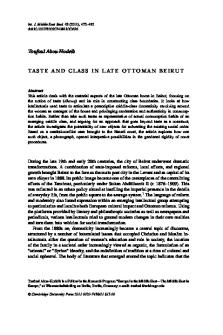From ‘brothers in religion’ to ‘bandits’: Chechens in Mardin in the late Ottoman period PDF

| Title | From ‘brothers in religion’ to ‘bandits’: Chechens in Mardin in the late Ottoman period |
|---|---|
| Author | Caner Yelbaşı |
| Pages | 2 |
| File Size | 255.2 KB |
| File Type | |
| Total Downloads | 382 |
| Total Views | 430 |
Summary
Middle Eastern Studies ISSN: (Print) (Online) Journal homepage: https://www.tandfonline.com/loi/fmes20 From ‘brothers in religion’ to ‘bandits’: Chechens in Mardin in the late Ottoman period Caner Yelbaşı & Ekrem Akman To cite this article: Caner Yelbaşı & Ekrem Akman (2021): From ‘brothers ...
Description
Middle Eastern Studies
ISSN: (Print) (Online) Journal homepage: https://www.tandfonline.com/loi/fmes20
From ‘brothers in religion’ to ‘bandits’: Chechens in Mardin in the late Ottoman period Caner Yelbaşı & Ekrem Akman To cite this article: Caner Yelbaşı & Ekrem Akman (2021): From ‘brothers in religion’ to ‘bandits’: Chechens in Mardin in the late Ottoman period, Middle Eastern Studies, DOI: 10.1080/00263206.2021.1998003 To link to this article: https://doi.org/10.1080/00263206.2021.1998003
Published online: 10 Nov 2021.
Submit your article to this journal
Article views: 21
View related articles
View Crossmark data
Full Terms & Conditions of access and use can be found at https://www.tandfonline.com/action/journalInformation?journalCode=fmes20
Middle eastern studies https://doi.org/10.1080/00263206.2021.1998003
From ‘brothers in religion’ to ‘bandits’: Chechens in Mardin in the late Ottoman period Caner Yelbaşı
and Ekrem Akman
Mardin artuklu university, artuklu, Mardin, turkey
During the nineteenth century, the Ottoman state experienced considerable difficulties in maintaining complete control of both its governance and its territories. The state therefore focused on modernising its military capabilities, as well as establishing its bureaucracy and state structure as an attempt to shore up these weaknesses. From the time of Selim III (1779–1807), the state sought to focus on improving its military capacity in order to withstand the might of hostile European powers. The Ottoman elites were also aware that the Ottoman state could not survive with the existing structure, and thus considered reform vital to maintaining the empire. In addition to the threat from external military conflicts the Ottoman state was also vulnerable because of the spread of nationalist ideas, coupled with deficits in its economy and an incompetent bureaucracy. The Russian conquest of the North Caucasus during the middle of the nineteenth century also resulted in major problems for the state, in particular the mass movement of refugees to Ottoman lands. During this period, various North Caucasian groups, totalling over a million individuals, moved to the Ottoman Empire, commencing from the early 1860s and during the post-Russian-Ottoman War of 1877–78 and the late 1880s.1 The majority of these people were Circassians, along with a number of Abkhazians, Chechens, Dagestanis and Ossetians. This current article examines one from among this group – the Chechens – and their journey to the Ottoman Empire, focusing particularly on those eventually settling in the Mardin region. The article shall also give a brief overview of their journey, which commenced in the North Caucasus and followed the Batum, Ardahan, Çıldır, Kars, Erzurum and Mardin route. One could say that the Ottoman state aimed to place the Chechens on its south eastern frontier since taxation, security and state control were not as successful as the state had hoped for in the post-Tanzimat era in the region. By taking this step, the Ottoman state could increase its tax income and provide security for further agricultural production and refugee settlement in the region. As far as could be seen from Ottoman state archival sources, the Ottoman state did not have a consistent policy to settle refugees in its territory. Following the ever-increasing number of refugees arriving in the Ottoman Empire, the state used certain policies to organize those refugees who arrived for its own advantage. Some of the muhacirs were settled in areas where there were problems,2 others were settled in areas to balance the Muslim-Christian populations or increase the number of Muslim people in areas where Muslims were disproportionately represented,3 and some such as the Chechens were settled on the frontiers so that the Ottomans could maintain control of the region in terms of security, finance and providing order. It must be stressed that the state expected loyalty from these muhacirs as the state was a Caliphate which showed benevolence to the Muslim peoples who were arriving. To increase the financial stability of the region and attain sustainable financial benefit from the refugees, the Ottoman state was to execute a host of policies. These included providing agricultural tools CONTACT Caner Yelbaşı
[email protected]
© 2021 informa uK limited, trading as taylor & Francis Group...
Similar Free PDFs

Astronomy IN THE Abbasid Period
- 2 Pages

Religion in Media
- 1 Pages

Classical Period in Literature
- 4 Pages

Literature in Gupta period
- 3 Pages
Popular Institutions
- Tinajero National High School - Annex
- Politeknik Caltex Riau
- Yokohama City University
- SGT University
- University of Al-Qadisiyah
- Divine Word College of Vigan
- Techniek College Rotterdam
- Universidade de Santiago
- Universiti Teknologi MARA Cawangan Johor Kampus Pasir Gudang
- Poltekkes Kemenkes Yogyakarta
- Baguio City National High School
- Colegio san marcos
- preparatoria uno
- Centro de Bachillerato Tecnológico Industrial y de Servicios No. 107
- Dalian Maritime University
- Quang Trung Secondary School
- Colegio Tecnológico en Informática
- Corporación Regional de Educación Superior
- Grupo CEDVA
- Dar Al Uloom University
- Centro de Estudios Preuniversitarios de la Universidad Nacional de Ingeniería
- 上智大学
- Aakash International School, Nuna Majara
- San Felipe Neri Catholic School
- Kang Chiao International School - New Taipei City
- Misamis Occidental National High School
- Institución Educativa Escuela Normal Juan Ladrilleros
- Kolehiyo ng Pantukan
- Batanes State College
- Instituto Continental
- Sekolah Menengah Kejuruan Kesehatan Kaltara (Tarakan)
- Colegio de La Inmaculada Concepcion - Cebu











